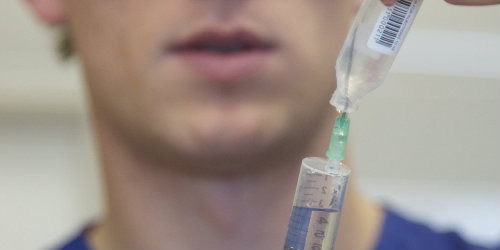Landmark discoveries that could dramatically improve cardiac care
Research into the regulation of calcium in cardiac muscle cells uses computer models to further understanding of molecular control and develop new ways to treat heart failure.
The regulation of calcium in cardiac muscle cells is a well-documented problem that physiologists, biophysicists and mathematicians have made steps towards solving over the past century. Yet there remain major gaps in our understanding of how this process, the failure of which leads to heart failure and heart disease, works at the cellular level.
By applying high resolution imaging techniques and incorporating physiological data into mathematical models, Professor Mark Cannell, currently Chair in Cardiac Cell Biology at the School of Physiology and Pharmacology, has made a series of landmark discoveries that could ultimately allow for dramatic improvements in clinical practice as well as scientific knowledge. His research demonstrates how vital basic scientific investigations are to making long-term progress in understanding and treating conditions.
Researching cell signalling and calcium release
Those discoveries have been the result of many years’ rigorous, collaborative and internationally renowned research. The first major breakthrough came in 1992 when Professor Cannell solved one of the long-standing puzzles about ‘excitation contraction coupling’ – the process by which the electrical signal in the heart cell membrane leads to calcium release, which causes the heart to contract.
Each beat of the heart is due to the rapid and synchronised release of calcium into each heart cell. The level of calcium that is released impacts on the heart’s contraction, and defective calcium signalling is a cause of heart failure.
By using confocal microscopy, Professor Cannell was able to detect the nonuniformities in calcium levels in cardiac muscle cells. His images revealed flashes of calcium – the ‘calcium sparks’ that have revolutionised understanding of cardiac excitation contraction coupling.
Understanding calcium sparks and signal control
Calcium sparks result when a local increase in the level of cellular calcium causes a calcium-induced calcium release in individual cells. This allows individual cells to regeneratively increase their activation in a way that is controlled. The calcium sparks further showed that at a cellular level, spatial distribution of signaller and sensor pairs is important to prevent signals becoming confused with those from other pairs.
The discovery that intracellular mechanism of calcium signal amplification works in a way that can be self-controlling was the focus of a landmark paper for the Journal of Science. The 1993 paper, written by Cannell and his colleagues Peace Cheng and John Lederer, has been so influential that it has been cited more than 1,400 times and has increased understanding of signalling in other cell types.
At the exact same time that Professor Cannell’s team found a physiological solution, a mathematician similarly demonstrated that a uniform signalling system could not work correctly and the idea of ‘local control’ in cell signalling was born. How to terminate calcium-induced calcium release during the calcium spark itself then became the next challenge.
Using computer models to find answers
Resolving that dilemma prompted Professor Cannell to turn to computer modelling. He and his research associates created a computer model that included their best understanding of the geometry of the biophysical system, into which they programmed the data obtained from observing the physiological opening and closing of the ion channels that cause calcium release.
In 2012, 20 years after he and others in the field began working on this challenge, Professor Cannell finally found an answer. The computer model revealed that calcium sparks were being terminated automatically through a process that he termed ‘induction decay’.
“It was one of those Eureka moments. It seemed obvious that it should work that way once we discovered it." - Prof Mark Cannell
The process of induction decay centres on the length of time ion channels are closed, which in turn depends on the local calcium levels surrounding the channels; the channels only re-open if the level of calcium around them is high enough. As the flux of calcium starts to go down, the local calcium levels also drop - so closed channels stay closed for longer and longer. Professor Cannell realised that if none of the closed channels reopened before the nearby open channel closed, then regeneration stops.
Developing new approaches to treat heart failure
Professor Cannell’s research focus has now turned to exploring how excitation contraction coupling can be re-tuned, so as to control the gating mechanisms of the ion channels in the cell. A greater understanding could lead to a new approachto the treatment of heart failure and much-needed improvements in long term prognosis.
“As we understand the micro-architecture of the cell structure and the properties of proteins that control function, then with the help of computer modelling, we can begin to put this incredibly complex system back together again and develop methods for molecular control.” - Prof Mark Cannell
While this research could take more than another decade before it reaches widespread clinical application, Professor Cannell emphasises how vital such basic science investigations are for long term progress: “Basic science doesn’t get into the market on a short timescale. It’s taken a 130 years of research on calcium signalling to get to where we are now, but we need to keep working on fundamental science to build the understanding that has, and will, lead to better treatments.”
Related researchers
Related research centres
Related publications
- Calcium Sparks - Elementary Events Underlying Excitation-Contraction Coupling in Heart-Muscle
- The control of calcium release in heart muscle
- Local control in cardiac excitation-contraction coupling
- Termination of calcium-induced calcium release by induction decay: An emergent property of stochastic channel gating and molecular scale architecture
- Effect of SR load and pH regulatory mechanisms on stretch-dependent Ca2+ entry during the slow force response
- Imaging Ca2+ Nanosparks in Heart with a New Targeted Biosensor
 Support groundbreaking research
Support groundbreaking research
Your donations turn our passion for research into life-changing results.
